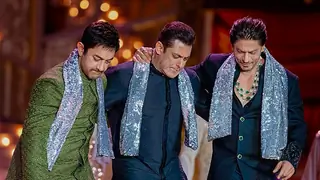Your comments are welcome and please add their songs to all these legendary singers, but please keep it short and simple (no comparisons please).
This is just a brief introduction of all the great singers from Ido-pak, you can add to this thread, I am just trying to give a brief introduction of all these legends (just the beginning of their careers).
Introduction to Lataji, Ashaji, and Mehdi Hassan to follow in part 2.
K L Saigal
Name: Kundan Lal Saigal
Born: April 11, 1904 - Jammu
Died: Jan. 18, 1947 (befroe partition)
Considered the best singer of his era - no doubt about it
Calcutta was the center of Bollywood during that era (now Mumbai)
In a career of fifteen years, Saigal acted in 36 feature films 28 in Hindi/Urdu, 7 in Bengali, and 1 in Tamil. In addition, he acted in a short comedy Hindi/Urdu film, Dulari Bibi (3 reels), released in 1933, In all, Saigal rendered 185 songs which includes 142 film songs and 43 non-film songs. In the film songs category, there are 110 in Hindi/Urdu, 30 in Bengali and 2 in Tamil.
Saigal's distinctive singing voice was so melodious and popular that he was idolized by the first generation of post-independence Bollywood playback singers, including Lata Mangeshkar, Mohammad Rafi,
Mukesh, and Kishore Kumar.
Mohammad Rafi
Born: December 24, 1924
Died: July 31, 1980
A popular Indian playback singer. A versatile singer,Rafi sang in many Indian languages including Hindi, Urdu, Punjabi, Bengali, Marathi, Kannada
and Telugu. He is primarily remembered, however, for his Hindi songs, which still remain very popular in the Indian subcontinent. He was the leading male
Bollywood playback singers from the 1950s to the 1970s. He was awarded the Padma Shri in 1965.
In 1944, Rafi moved to Bombay (now Mumbai), where he was introduced to some of the leading film producers of the time such as Abdul Rashid Kardar, Mehboob Khan and actor-director Nazeer by Tanvir Naqvi.Rafi contacted the famous music director Naushad, who initially used him as part of the chorus. Rafi's first song with Naushad was Hindustan ke hum hain with Shyam Kumar, Alauddin and others.
In 1945, Rafi appeared on the screen for the song "Tera Jalwa Jis Ne Dekha" in the film Laila Majnu. He sang a number of songs for Naushad as part of the chorus, including "Mere sapnon ki rani, Roohi Roohi" with K. L. Saigal.
Rafi was first noted for the song Tera Khilona Toota Balak from Mehboob Khan's Anmol Ghadi. His duet with Noor Jehan in the film Jugnu 1947, Yahan Badla Wafa Ka became a hit. Following partition, Rafi decided to stay back in India and had his family flown to Bombay.
In 1948, Rafi sang "Suno Suno Aye Duniya Walon Bapuji Ki Amar Kahani, written by Rajendra
Krishan, which became a huge hit. He was invited by the Indian Prime Minister, Jawaharlal Nehru, to sing at the latter's house. In 1948, Rafi received a silver medal from Nehru on the Indian Independence Day. In 1949, Rafi was given solo songs by music directors such as Naushad (Chandni Raat, Dillagi and Dulari), Shyam Sunder (Bazaar) and Husnalal Bhagatram (Meena Bazaar).
Noor Jehan
Birth Date: Sept. 21, 1926
Died: December 2000
Birth Place: Kassur (Pakistan)
Five brothers - Nawab Din, Gul Muhammad, Muhammad Hussain, Muhammad Shafi and Inayat Hussain and five sisters - Eidan Bai, Haider Baandi, Gulzar Begum, Meena Begum and Undam Begum.
From an early age she displayed signs of having a melodious voice. Realising her immense talent Noor Jehan's mother started her training in singing and dancing. She took up singing when she was only seven when she started making appearances on stage. She did not sing original songs but the famous film hits of the day. She came to Lahore with her sisters for better opportunities.
Looking for an even bigger stage the sisters moved to Calcutta in 1934/1935 where Mukhtar Begum, the leading singing star of the stage, encouraged her and recommended them to various producers. In later life Noor Jehan adopted Mukhtar Begum's style of performing. At this time, director K D Mehra was in the process of making a Punjabi film and persuaded his producer to cast the three (Noor Jahan and sisters) in Pind Di Kuri (1935). And so began the film career of Baby Noor Jehan. She next acted in a film called Misar Ka Sitara (1936) by the same company and sang in it for composer Damodar Sharma. Five films later Baby Noor Jahan played the role of Heer's childhood in the film Heer Sayyal (1937).
After four years in Calcutta back in Lahore it was Master Ghulam Haider who spotted her immense talent as a singer and composed songs that made her famous overnight. Baby Noor Jehan hit the nationwide rating with Gul Bakawali (1939) for renowned Mumbai producer Dalsukh Pancholi in 1939 where she recorded her first film song 'Shala Jawaniyan Mane' that was an instant hit.
Noor Jehan was first cast as a heroine in Khandan (1942) opposite Pran (who later became Indian Cinema's most hated villain) as the hero. The film was also a debut for director Shaukat Hussain Rizvi (who later married Noor Jehan). The songs of Khandan (1942) composed by Ghulam Haider became instant hits and established her as the leading singer of films in India. Its success saw her immigrating to Bombay where she shared melodies with the singing star Shanta Apte in Duhai (1943). After that there was hit after hit with songs from Nadan (1943), Naukar (1943), Dost (1944), Lal Haveli (1944). By now her popularity outstripped all others. She was the darling of the masses, recognised and adored both for her singing and acting.
After taking the role of leading lady in Nadan (1943), she was presented with second lead in Naukar (1943). In 1944, a film directed by Rizvi, had the extremely gifted Motilal as the leading man opposite Noor Jehan, It was in this film that Noor Jehan lent her voice for the first time to another actress, Husn Bano. It was in Lal Haveli (1944) that Noor Jehan starred opposite singing star Surendra Nath for the first time (they later made the all time classic Anmol Ghadi (1946)). Lal Haveli (1944) was also notable for the fact that Meena Kumari, then a child star, acted as the young Noor Jehan.
The year 1945 was a turning point for Noor Jehan. In Master Vinayak's Badi Maa (1945) she played lead with "Baby Lata Mangeshkar" and "Baby Asha Mangeshkar" in supporting roles. Noor Jehan's influence on the early songs of Lata is still discernible. Lata has always respected Noor Jehan and considers her one of her favourite singers. Some critics even believe that if Noor Jehan hadn't left fame and fortune in India when migrating to Pakistan during the partition of India, Lata may not have been as successful as she is today.
The year 1945 also brought Noor Jehan her first superhit in Bombay, Zeenat (1945). It was her inimitable rendition of "Bulbulo Mat Ro Yahan" that gained her the title Malka-e-Tarranum, Queen of Melody. She dethroned reigining singing star Khurshid and rendered obsolete the nautch girl style of Zohra Ambalewali and Amirbai Karnatki.
In 1946 Noor Jehan acted in the enduring classic Anmol Ghadi (1946). The title is a fitting description of the magical moments in this film with superhit songs like 'Awaz De Kahan Hai', 'Jawan Hai Mohabbat', 'Mere Bachpan Ke Saathi', 'Aaja Meri Barbad Mohabbat' and 'Kya Mil Gaya Bhagwan' composed by Naushad to make her the undisputed queen of films. So popular was the film that Noor Jehan's other two films released that year, Dil (1946) and Humjoli (1946), were pale in comparison.
In Jugnu (1947) she starred with Dilip Kumar, then a rising star. The duet 'Yahan Badla Wafa Ka Bewafai Ke Siva Kya Hai' catapulted the then struggling Mohammed Rafi. Noor Jehan had very few duets as her voice did not require the support or enhancement of others.
Noor Jehan's last film in India was Mirza Sahiban (1947) which starred Prithviraj. Many of the songs were hits like 'Aaja Tujhe Afsana Judaai Ka Sunaye' and the duet with G M Durrani 'Haath Seene Pe Jo Rakh Do To Qarar Aaye'.




























